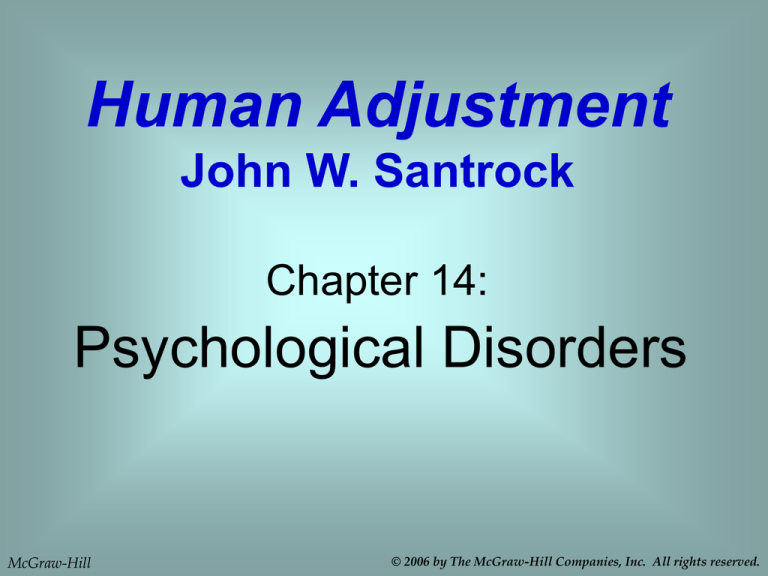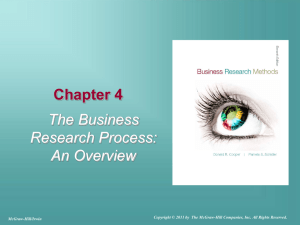
Human Adjustment
John W. Santrock
Chapter 14:
Psychological Disorders
McGraw-Hill
© 2006 by The McGraw-Hill Companies, Inc. All rights reserved.
14-2
Chapter Outline
Understanding Abnormal Behavior
Anxiety Disorders
Dissociative Disorders
Mood Disorders
Schizophrenia
Personality Disorders
McGraw-Hill
©2006 by the McGraw-Hill Companies, Inc. All rights reserved.
14-3
Learning Goals
1. Discuss characteristics and classification of
abnormal behavior
2. Distinguish among various anxiety disorders
3. Describe the dissociative disorders
4. Compare the mood disorders and specify risk
factors for depression and suicide
5. Identify characteristics and possible causes of
schizophrenia
6. Identify behavior patterns typical of personality
disorders
McGraw-Hill
©2006 by the McGraw-Hill Companies, Inc. All rights reserved.
UNDERSTANDING ABNORMAL
BEHAVIOR
14-4
Defining Abnormal Behavior
Theoretical Approaches to Psychological
Disorders
Classifying Abnormal Behavior
McGraw-Hill
©2006 by the McGraw-Hill Companies, Inc. All rights reserved.
14-5
Defining Abnormal Behavior
Abnormal behavior = behavior that is deviant,
maladaptive or personally distressful
Deviant - atypical behavior, deviates from acceptable
norms
Maladaptive - interferes with person’s ability to
function effectively
Personal distress - person does not feel right
McGraw-Hill
©2006 by the McGraw-Hill Companies, Inc. All rights reserved.
Theoretical Approaches
to Psychological Disorders
14-6
Causes of psychological disorders include biological,
psychological, and sociocultural factors and the
possibility of a combination of factors
McGraw-Hill
©2006 by the McGraw-Hill Companies, Inc. All rights reserved.
14-7
The Biological Approach
The biological approach attributes psychological
disorders to organic, internal causes
Biological factors that contribute to psychological
disorders:
– abnormalities in brain structure
– imbalances in neurotransmitters or hormones
– disordered genes
McGraw-Hill
©2006 by the McGraw-Hill Companies, Inc. All rights reserved.
14-8
The Biological Approach
Medical model = describes psychological disorders
as medical diseases with a biological origin
Medical model:
– abnormalities are mental illnesses
– individuals afflicted are patients
– patients are treated by doctors, often with drugs
McGraw-Hill
©2006 by the McGraw-Hill Companies, Inc. All rights reserved.
14-9
The Psychological Approach
The psychodynamic, behavioral, social cognitive, and
humanistic perspectives serve as foundations for
understanding psychological factors in psychological
disorders
McGraw-Hill
©2006 by the McGraw-Hill Companies, Inc. All rights reserved.
14-10
The Psychological Approach
Psychodynamic perspective - psychological
disorders arise from unconscious conflicts that produce
anxiety
Behavioral perspective - rewards and punishments in
the environment shape abnormal behavior
Social cognitive perspective - environment,
observational learning, expectancies, self-efficacy, selfcontrol, and beliefs are key factors in abnormal
behavior
McGraw-Hill
©2006 by the McGraw-Hill Companies, Inc. All rights reserved.
14-11
The Sociocultural Approach
Sociocultural approach - emphasis on larger social
contexts in which a person lives (individual’s marriage
or family, socioeconomic status, ethnicity, gender,
culture)
Frequency and intensity of psychological disorders
varies across cultures and depends on social,
economic, technological, and religious aspects
McGraw-Hill
©2006 by the McGraw-Hill Companies, Inc. All rights reserved.
An Interactionist Approach:
Biopsychosocial
14-12
Biopsychosocial approach - abnormal behavior can
be influenced by:
– biological factors (such as brain processes and heredity)
– psychological factors (such as distorted thoughts or low
self-esteem)
– sociocultural factors (such as ineffective family
functioning or poverty)
McGraw-Hill
©2006 by the McGraw-Hill Companies, Inc. All rights reserved.
Classifying Abnormal Behavior DSM-IV-TR
14-13
American Psychiatric Association first published
Diagnostic and Statistical Manual of Mental Disorders
in 1952
– DSM-IV-TR (4th edition, text revision) was published in
2000
– DSM-IV-TR has multiaxial system which classifies
individuals on the basis of five dimensions, or axes
– DSM reflects the medical model
McGraw-Hill
©2006 by the McGraw-Hill Companies, Inc. All rights reserved.
14-14
The Issue of Labeling
DSM classification is controversial:
– it labels as disorders what are thought of as everyday
problems
– it has bias toward finding something wrong
– it puts labels on people
Despite disadvantages, DSM-IV-TR is comprehensive
and allows clinicians to make predictions
McGraw-Hill
©2006 by the McGraw-Hill Companies, Inc. All rights reserved.
14-15
Review - Learning Goal 1
– What is abnormal behavior?
– What factors might be involved in the etiology of
psychological disorders?
– How does the Diagnostic and Statistical Manual of Mental
Disorders classify psychological disorders and what are its
advantages and disadvantages?
McGraw-Hill
©2006 by the McGraw-Hill Companies, Inc. All rights reserved.
14-16
ANXIETY DISORDERS
Generalized Anxiety Disorder
Panic Disorder
Phobia Disorders
Obsessive-Compulsive Disorder
McGraw-Hill
©2006 by the McGraw-Hill Companies, Inc. All rights reserved.
14-17
Generalized Anxiety Disorder
Anxiety disorders - psychological disorders that
include:
– motor tension (jumpiness, trembling, inability to relax)
– hyperactivity (dizziness, racing heart, perspiration)
– apprehensive expectations and thoughts
McGraw-Hill
©2006 by the McGraw-Hill Companies, Inc. All rights reserved.
14-18
Generalized Anxiety Disorder
Generalized anxiety disorder - consists of persistent
anxiety over at least one month; the individual with this
disorder cannot specify reasons for the anxiety
McGraw-Hill
©2006 by the McGraw-Hill Companies, Inc. All rights reserved.
14-19
Generalized Anxiety Disorder
About 4 million Americans from 18 to 54 years of age
have generalized anxiety disorder
Biological factors include genetic predisposition and
deficiency of the neurotransmitter GABA
Psychological and sociocultural factors include overly
strict and critical parents and negative thoughts when
stressed
McGraw-Hill
©2006 by the McGraw-Hill Companies, Inc. All rights reserved.
14-20
Panic Disorder
Panic disorder = anxiety disorder marked by recurrent
sudden onset of intense apprehension or terror
About 2.4 million Americans have panic disorder
McGraw-Hill
©2006 by the McGraw-Hill Companies, Inc. All rights reserved.
14-21
Panic Disorder
Panic attacks strike without warning and produce:
– severe palpitations
– shortness of breath
– chest pains
– trembling
– sweating
– dizziness
– feeling of helplessness
McGraw-Hill
©2006 by the McGraw-Hill Companies, Inc. All rights reserved.
14-22
Agoraphobia
Agoraphobia = cluster of fears centered around
public places and being unable to escape or to find
help should one become incapacitated
McGraw-Hill
©2006 by the McGraw-Hill Companies, Inc. All rights reserved.
14-23
Agoraphobia
People with agoraphobia have fears of:
– crowded public places
– traveling away from home
– feeling confined
– being separated from a place or a person
McGraw-Hill
©2006 by the McGraw-Hill Companies, Inc. All rights reserved.
14-24
Panic Disorder
Biological factors in panic disorder include:
– overreaction to lactic acid
– genetic predisposition
– overactive autonomic nervous system
– problems with neurotransmitters norepinephrine and GABA
McGraw-Hill
©2006 by the McGraw-Hill Companies, Inc. All rights reserved.
14-25
Panic Disorder
Psychological factors in panic disorder include:
– stressful life event
– separation from loved one
– change in job
McGraw-Hill
©2006 by the McGraw-Hill Companies, Inc. All rights reserved.
Adjustment Strategies
for Coping with Panic
14-26
1. Retreat
2. Divert your attention
3. Engage in deep breathing relaxation and positive
self-talk
McGraw-Hill
©2006 by the McGraw-Hill Companies, Inc. All rights reserved.
14-27
Phobic Disorders
Phobic disorder = anxiety disorder in which individual
has irrational, overwhelming, persistent fear of a
particular object or situation
About 6.3 million Americans have a phobic disorder
McGraw-Hill
©2006 by the McGraw-Hill Companies, Inc. All rights reserved.
14-28
Phobic Disorders
Common phobias involve:
– social situations
– dogs
– height
– dirt
– flying
– snakes
Social phobia - intense fear of being humiliated or
embarrassed in social situations
McGraw-Hill
©2006 by the McGraw-Hill Companies, Inc. All rights reserved.
14-29
Figure 14.3 Phobias
McGraw-Hill
©2006 by the McGraw-Hill Companies, Inc. All rights reserved.
Figure 14.4 Social Phobias in
the United States
McGraw-Hill
14-30
©2006 by the McGraw-Hill Companies, Inc. All rights reserved.
14-31
Phobic Disorders
Biological factors:
– genetic
– neural circuit (thalamus, amygdala, cerebral cortex)
– neurotransmitter serotonin
Psychological factors:
– defense mechanisms
– learned fears
McGraw-Hill
©2006 by the McGraw-Hill Companies, Inc. All rights reserved.
14-32
Obsessive-Compulsive Disorder
Obsessive-compulsive disorder (OCD) = anxiety
disorder; individual has anxiety-provoking thoughts that
will not go away (obsession) and/or urges to perform
repetitive, ritualistic behaviors to prevent or produce
some future situation (compulsion)
About 3.3 million Americans have obsessivecompulsive disorder
McGraw-Hill
©2006 by the McGraw-Hill Companies, Inc. All rights reserved.
14-33
Obsessive-Compulsive Disorder
Common compulsions include:
– checking
– cleansing
– counting
McGraw-Hill
©2006 by the McGraw-Hill Companies, Inc. All rights reserved.
14-34
Obsessive-Compulsive Disorder
Biological factors
– genetic
– brain pattern
– depletion of neurotransmitter serotonin
McGraw-Hill
©2006 by the McGraw-Hill Companies, Inc. All rights reserved.
14-35
Obsessive-Compulsive Disorder
Psychological factors
– life stress
– occupation change
– marriage change
McGraw-Hill
©2006 by the McGraw-Hill Companies, Inc. All rights reserved.
Adjustment Strategies
for Coping with an Anxiety Disorder
14-36
1. Understand that effective treatments are available
2. Ask the therapist what training and experience he or
she has in treating anxiety disorders
3. Expect therapist to conduct a thorough diagnostic
evaluation
4. Recognize that the length of treatment required can
vary
5. Recognize that if one treatment doesn’t work,
another one will
McGraw-Hill
©2006 by the McGraw-Hill Companies, Inc. All rights reserved.
14-37
Review - Learning Goal 2
– What are anxiety disorders and what is generalized anxiety
disorder?
– What are the key features of panic disorder?
– Is having a phobic disorder different from a normal fear, and
what might cause it?
– What is obsessive-compulsive disorder?
McGraw-Hill
©2006 by the McGraw-Hill Companies, Inc. All rights reserved.
14-38
DISSOCIATIVE DISORDERS
Dissociative Amnesia and Fugue
Dissociative Identity Disorder
McGraw-Hill
©2006 by the McGraw-Hill Companies, Inc. All rights reserved.
14-39
Dissociative Disorders
Dissociative disorders = psychological disorders that
involve sudden loss of memory or change in identity
Under extreme stress, individual’s conscious
awareness becomes dissociated (separated) from
previous memories
McGraw-Hill
©2006 by the McGraw-Hill Companies, Inc. All rights reserved.
14-40
Dissociative Amnesia and Fugue
Three types of dissociative disorders:
– Dissociative amnesia - extreme memory loss caused by
extensive psychological stress
– Dissociative fugue - individual not only develops amnesia
but also travels away from home and establishes new
identity
– Dissociative identity disorder (DID) - individuals have two
or more distinct personalities
McGraw-Hill
©2006 by the McGraw-Hill Companies, Inc. All rights reserved.
14-41
Review - Learning Goal 3
– What are the characteristics of the dissociative disorders,
dissociative amnesia, and fugue?
– What is dissociative identity disorder?
McGraw-Hill
©2006 by the McGraw-Hill Companies, Inc. All rights reserved.
14-42
MOOD DISORDERS
Depressive Disorders
Bipolar Disorder
Causes of Mood Disorders
Suicide
McGraw-Hill
©2006 by the McGraw-Hill Companies, Inc. All rights reserved.
14-43
Mood Disorders
Mood disorders = psychological disorders in which
there is a disturbance in mood (prolonged emotion that
colors the individual’s entire emotional state)
Two types of mood disorders:
– depressive disorders
– bipolar disorder
McGraw-Hill
©2006 by the McGraw-Hill Companies, Inc. All rights reserved.
14-44
Depressive Disorders
Major depressive disorder (MDD) - individual
experiences a major depressive episode with
symptoms lasting at least two weeks
Dysthymic disorder - more chronic and has fewer
symptoms then major depressive disorder
McGraw-Hill
©2006 by the McGraw-Hill Companies, Inc. All rights reserved.
14-45
Depressive Disorders
Major depressive episode - individual experiences at
least 5 symptoms for at least 2 weeks:
– depressed mood most of the day
– reduced interest or pleasure in most activities
– significant weight change or significant appetite change
– trouble sleeping or sleeping too much
– psychomotor agitation or retardation
– fatigue or loss of energy
– feeling worthless or guilty
– problems in thinking, concentration, or making decisions
– recurrent thoughts of death and suicide
McGraw-Hill
©2006 by the McGraw-Hill Companies, Inc. All rights reserved.
Adjustment Strategies
for Coping with Depression
14-46
For the Depressed Individual:
1. Recognize that feeling exhausted, worthless,
helpless, and hopeless are part of the depression
2. See a therapist
McGraw-Hill
©2006 by the McGraw-Hill Companies, Inc. All rights reserved.
Adjustment Strategies
for Coping with Depression
14-47
For Family and Friends:
1. Help individual get competent diagnosis and
treatment
2. Offer emotional support
3. Invite the depressed person to activities
4. Encourage the depressed individual to participate in
activities that he or she once enjoyed
5. Don’t expect him or her to “snap out of it”
McGraw-Hill
©2006 by the McGraw-Hill Companies, Inc. All rights reserved.
14-48
Bipolar Disorder
Bipolar disorder = mood disorder characterized by
extreme mood swings that include one or more
episodes of mania
– Most bipolar individuals experience multiple cycles of
depression interspersed with manic episodes
McGraw-Hill
©2006 by the McGraw-Hill Companies, Inc. All rights reserved.
14-49
Bipolar Disorder
Manic episode occurs when a person:
– feels euphoric
– has tremendous energy
– is impulsive
McGraw-Hill
©2006 by the McGraw-Hill Companies, Inc. All rights reserved.
14-50
Biological Causes of Mood Disorders
Biological causes of mood disorders include:
– heredity
– neurobiological abnormalities
– altered brain wave activity during sleep
– decrease in brain metabolic activity
– neuron death
– imbalance of monoamine neurotransmitters
(norepinephrine, serotonin, dopamine)
– hormones
McGraw-Hill
©2006 by the McGraw-Hill Companies, Inc. All rights reserved.
14-51
Psychological Factors in Mood Disorders
Psychodynamic theories emphasize childhood
experiences that prevented the person from developing
a strong, positive sense of self
Freud suggested depression is a turning inward of
aggressive instincts
McGraw-Hill
©2006 by the McGraw-Hill Companies, Inc. All rights reserved.
Behavioral Explanations
of Mood Disorders
14-52
Behavioral explanations include reduction of positive
reinforcers
Learning Helplessness = occurs when individuals are
exposed to aversive stimulation, such as prolonged
stress, over which they have no control
McGraw-Hill
©2006 by the McGraw-Hill Companies, Inc. All rights reserved.
Cognitive Explanations
of Mood Disorders
14-53
Cognitive explanations include:
– Depressed individuals interpret life in a negative way
– Individuals with a pessimistic cognitive style are more likely
to be depressed
Depressive realism - depressed individuals
accurately view the world
McGraw-Hill
©2006 by the McGraw-Hill Companies, Inc. All rights reserved.
Sociocultural Factors
in Mood Disorders
14-54
Sociocultural factors
– Incidence and intensity of depression varies across cultures
Socioeconomic and ethnic factors
– Individuals living in poverty are more likely to be depressed
Bipolar disorder occurs equally in men and women, but
women are twice as likely to develop depression
McGraw-Hill
©2006 by the McGraw-Hill Companies, Inc. All rights reserved.
14-55
Suicide
Depression can cause individuals to want to commit
suicide
– Suicide is third leading cause of death in U.S. adolescents
Females are more likely to attempt suicide, but males
are more likely to actually commit suicide
McGraw-Hill
©2006 by the McGraw-Hill Companies, Inc. All rights reserved.
14-56
Suicide
Biological factors in suicide include:
– genetic
– low levels of the neurotransmitter serotonin
– poor physical health
McGraw-Hill
©2006 by the McGraw-Hill Companies, Inc. All rights reserved.
14-57
Suicide
Psychological factors in suicide include:
– psychological disorders
– traumas (such as sexual abuse)
– highly stressful circumstances
McGraw-Hill
©2006 by the McGraw-Hill Companies, Inc. All rights reserved.
14-58
Suicide
Sociocultural factors in suicide include:
– loss of loved one
– family instability
– chronic economic hardship
McGraw-Hill
©2006 by the McGraw-Hill Companies, Inc. All rights reserved.
14-59
Adjustment Strategies for Communicating
with Someone Threatening Suicide
1. Ask direct questions in a calm manner
2. Be a good listener and be supportive
3. Take the suicide threat seriously
4. Encourage the person to get professional help and
assist him or her in getting help
McGraw-Hill
©2006 by the McGraw-Hill Companies, Inc. All rights reserved.
14-60
Review - Learning Goal 4
– What are mood disorders? How can the depressive
disorders be characterized?
– What are the main features of bipolar disorder?
– What causes mood disorders?
– What is the nature of suicide?
McGraw-Hill
©2006 by the McGraw-Hill Companies, Inc. All rights reserved.
14-61
SCHIZOPHRENIA
Types of schizophrenia
Causes of schizophrenia
McGraw-Hill
©2006 by the McGraw-Hill Companies, Inc. All rights reserved.
14-62
Schizophrenia
Schizophrenia = a severe psychological disorder
characterized by a highly disordered thought processes
About 2.2 million adults in the U.S. have schizophrenia
One half of patients in mental hospitals are individuals
with schizophrenia
McGraw-Hill
©2006 by the McGraw-Hill Companies, Inc. All rights reserved.
14-63
Schizophrenia
Symptoms of schizophrenia include:
– delusions
– hallucinations
– word salad
– bizarre behavior
– withdrawal
McGraw-Hill
©2006 by the McGraw-Hill Companies, Inc. All rights reserved.
14-64
Types of Schizophrenia
Disorganized schizophrenia - delusions and
hallucinations that have no meaning
Catatonic schizophrenia - bizarre motor behavior,
sometimes an immobile stupor
Paranoid schizophrenia - delusions of reference,
grandeur, and persecution
Undifferentiated schizophrenia - disorganized
behavior, hallucinations, delusions, and incoherence
McGraw-Hill
©2006 by the McGraw-Hill Companies, Inc. All rights reserved.
14-65
Causes of Schizophrenia
Biological factors in schizophrenia include:
– heredity
– brain abnormalities
– high levels of the neurotransmitter dopamine
– enlarged ventricles in brain
– small frontal cortex in brain
McGraw-Hill
©2006 by the McGraw-Hill Companies, Inc. All rights reserved.
14-66
Causes of Schizophrenia
Psychological factors in schizophrenia include:
– stress
Diathesis-stress model of schizophrenia combination of biogenetic disposition and stress
Sociocultural factors in schizophrenia include:
– poverty
McGraw-Hill
©2006 by the McGraw-Hill Companies, Inc. All rights reserved.
14-67
Review - Learning Goal 5
– What are the different types of schizophrenia?
– What factors appear to play a role in the etiology of
schizophrenia?
McGraw-Hill
©2006 by the McGraw-Hill Companies, Inc. All rights reserved.
14-68
PERSONALITY DISORDERS
Odd or Eccentric Cluster
Dramatic or Emotionally Problematic Cluster
Anxious or Fearful Cluster
McGraw-Hill
©2006 by the McGraw-Hill Companies, Inc. All rights reserved.
14-69
Personality Disorders
Personality disorders = chronic, maladaptive
cognitive-behavioral patterns that are thoroughly
integrated into the individual’s personality
McGraw-Hill
©2006 by the McGraw-Hill Companies, Inc. All rights reserved.
14-70
Odd or Eccentric Cluster
The odd or eccentric cluster of personality disorders
include:
– Paranoid - suspicious of others
– Schizoid - inadequate social relationships
– Schizotypal - odd thinking patterns
McGraw-Hill
©2006 by the McGraw-Hill Companies, Inc. All rights reserved.
Dramatic or Emotionally
Problematic Cluster
14-71
The dramatic or emotionally problematic cluster
include:
– Histrionic - tend to overreact
– Narcissistic - unrealistic sense of self-importance
– Borderline - emotionally unstable
– Antisocial - guiltless, law-breaking, self-indulgent,
irresponsible, and intrusive
McGraw-Hill
©2006 by the McGraw-Hill Companies, Inc. All rights reserved.
14-72
Anxious or Fearful Cluster
The anxious or fearful cluster includes:
– Avoidant - inhibited, but desire relationships
– Dependent - lack self-confidence
– Obsessive-compulsive - obsessed with rules
McGraw-Hill
©2006 by the McGraw-Hill Companies, Inc. All rights reserved.
14-73
Review - Learning Goal 6
– What are personality disorders?
– What is the odd or eccentric cluster?
– What is the dramatic or emotionally problematic cluster?
– What is the anxious or fearful cluster?
McGraw-Hill
©2006 by the McGraw-Hill Companies, Inc. All rights reserved.









